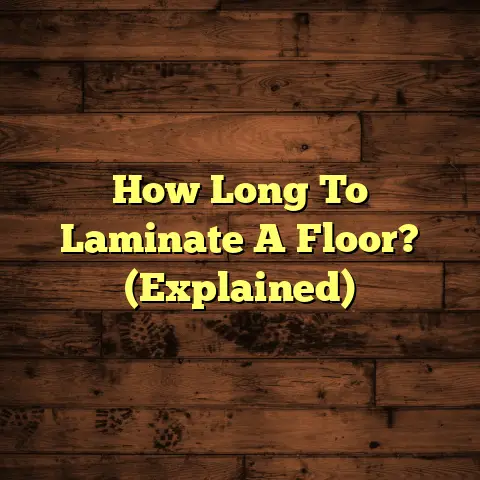Laminate Vs. Vinyl: Pros & Cons? (2 May Shock You!)
Choosing new flooring can feel like navigating a maze, right? When it comes to flooring, deciding between laminate and vinyl isn’t just about aesthetics – it’s about making a decision that could change the way you live in your space.
I’ve seen homeowners agonize over this choice for weeks, sometimes even months!
Are you ready to reconsider what you thought you knew about these materials? Let’s dive in and uncover some surprising truths about laminate and vinyl flooring!
Section 1: Overview of Laminate Flooring
Okay, let’s start with laminate. What exactly is it?
Essentially, laminate flooring is a multi-layer synthetic flooring product fused together through a lamination process. It typically consists of a high-density fiberboard (HDF) core, a decorative layer (that photo-realistic image you see), and a wear layer on top.
Think of it like a super-durable photo album for your floor!
A Brief History
The history of laminate is pretty interesting. It actually started gaining popularity in the late 1970s and early 1980s in Europe.
The idea was to create a more affordable and durable alternative to real hardwood. It quickly caught on, and now it’s a staple in homes worldwide.
Styles and Designs
One of the great things about laminate is the sheer variety of styles available. You can find laminate that mimics hardwood, stone, tile, and even some pretty unique abstract designs.
The advancements in printing technology have made these imitations incredibly realistic. I’ve had clients swear that their laminate floor was actually real wood!
Typical Applications
Where do you usually see laminate flooring?
Well, it’s commonly used in living rooms, bedrooms, hallways, and even kitchens. It’s a good all-around option for areas that see moderate foot traffic.
However, I usually advise against using it in bathrooms or laundry rooms due to its susceptibility to moisture – we’ll get to that later.
Section 2: Overview of Vinyl Flooring
Now, let’s switch gears and talk about vinyl flooring. This is another popular option, but it’s quite different from laminate in terms of composition and performance.
What is Vinyl Flooring?
Vinyl flooring is a resilient flooring made primarily of polyvinyl chloride (PVC). You’ve probably heard of PVC before – it’s a type of plastic.
There are several types of vinyl flooring, including:
- Sheet Vinyl: This comes in large rolls and is great for covering entire rooms with minimal seams.
- Luxury Vinyl Planks (LVP): These are individual planks that mimic the look of hardwood.
- Luxury Vinyl Tiles (LVT): Similar to LVP, but designed to look like stone or ceramic tiles.
A Look Back
Vinyl flooring has been around for quite a while, actually. It first appeared in the early 20th century and became increasingly popular after World War II.
Its durability and water resistance made it a hit, and it’s been a go-to choice for homeowners ever since.
Styles and Textures
Just like laminate, vinyl flooring comes in a huge range of styles, textures, and finishes. You can find vinyl that looks like everything from rustic wood to sleek marble.
Some vinyl even has embossed textures to make it feel more like the real thing underfoot.
Where It Shines
Vinyl flooring is incredibly versatile. You’ll often see it in bathrooms, kitchens, laundry rooms, and basements – basically, anywhere where moisture is a concern.
It’s also a popular choice for commercial spaces due to its durability and ease of maintenance.
Section 3: Pros of Laminate Flooring
Alright, let’s get into the nitty-gritty. What are the advantages of choosing laminate flooring?
Durability and Scratch Resistance
One of the biggest selling points of laminate is its durability. That wear layer I mentioned earlier? It’s designed to withstand a lot of abuse.
Laminate is generally resistant to scratches, dents, and stains, making it a good choice for homes with kids and pets.
I’ve seen laminate floors hold up remarkably well in high-traffic areas, even after years of use.
Cost-Effectiveness
Compared to hardwood, laminate is significantly more affordable. You can get the look of real wood without breaking the bank.
According to recent data, laminate flooring can cost anywhere from $2 to $8 per square foot, while hardwood can easily range from $8 to $20 or more.
Easy Installation and Maintenance
Laminate flooring is known for its easy installation. Most laminate floors use a click-lock system, which means the planks simply snap together.
This makes it a popular DIY project for homeowners.
Maintaining laminate is also a breeze. Regular sweeping and occasional damp mopping are usually all it takes to keep it looking its best.
Aesthetic Versatility
As I mentioned earlier, laminate comes in a wide variety of styles and designs. Whether you’re going for a rustic farmhouse look or a modern minimalist vibe, you can find a laminate floor to match.
The advancements in design technology have made laminate look more realistic than ever before.
Section 4: Cons of Laminate Flooring
Now, let’s talk about the downsides. What are the drawbacks of laminate flooring?
Susceptibility to Moisture
This is the big one. Laminate is not waterproof. If water seeps into the seams, it can cause the core to swell and warp.
I’ve seen countless laminate floors ruined by even minor leaks. That’s why I always caution against using it in areas prone to moisture.
Limited Lifespan
While laminate is durable, it doesn’t last as long as hardwood or even some types of vinyl. With proper care, a laminate floor might last 10-20 years.
Hardwood, on the other hand, can last for generations.
Fading and Wear
Over time, laminate can fade and show signs of wear, especially in areas that get a lot of sunlight. The wear layer can also become scratched or worn down, revealing the decorative layer underneath.
Noise Issues
Laminate flooring can sometimes be noisy to walk on, especially if it’s installed over a less-than-perfect subfloor. The hollow sound can be a real annoyance for some homeowners.
You can mitigate this by using a high-quality underlayment, but it’s still something to consider.
Section 5: Pros of Vinyl Flooring
Let’s switch back to the positive side and explore the benefits of vinyl flooring.
Water Resistance
This is where vinyl really shines. Vinyl flooring is inherently water-resistant, making it an excellent choice for bathrooms, kitchens, and laundry rooms.
Some vinyl products are even 100% waterproof, meaning they can withstand standing water without any damage.
Comfort and Warmth
Vinyl flooring tends to be softer and warmer underfoot than laminate or tile. This can make it a more comfortable option, especially in areas where you spend a lot of time standing.
Design Variety
Just like laminate, vinyl flooring comes in a huge array of styles and designs. You can find vinyl that mimics the look of hardwood, stone, tile, and even concrete.
The realistic wood and stone looks are particularly popular, and they can add a touch of luxury to any space.
Softness and Sound Absorption
Vinyl flooring is generally softer and more sound-absorbent than laminate. This can make it a great choice for families with young children or anyone who wants to reduce noise levels in their home.
Section 6: Cons of Vinyl Flooring
Okay, let’s be honest – vinyl flooring isn’t perfect. Here are some of the drawbacks to consider.
Environmental Concerns
The production and disposal of vinyl flooring can raise environmental concerns. PVC is a type of plastic, and the manufacturing process can release harmful chemicals into the environment.
However, many manufacturers are now using more sustainable practices and offering recycled vinyl options.
Potential for Scratches and Dents
While vinyl is durable, it’s not indestructible. It can be scratched by sharp objects or dented by heavy furniture.
Luxury vinyl is generally more resistant to scratches and dents than sheet vinyl, but it’s still something to keep in mind.
Installation Complexity
While some vinyl flooring is easy to install (like click-lock LVP), other types (like sheet vinyl) can be more challenging. Sheet vinyl requires careful cutting and seaming, and it’s often best left to the professionals.
Quality Variability
The quality of vinyl flooring can vary widely depending on the brand and the price point. Cheaper vinyl may be more prone to scratches, dents, and fading.
It’s always a good idea to do your research and choose a reputable brand.
Conclusion
So, there you have it – a comprehensive look at laminate and vinyl flooring. As you can see, the choice between the two is more nuanced than most people realize.
Both have their pros and cons, and the best option for you will depend on your specific needs, budget, and lifestyle.
I hope this article has helped you think critically about your flooring choices. Remember, the decision you make could impact your lifestyle more than you had anticipated. Good luck with your flooring project!





